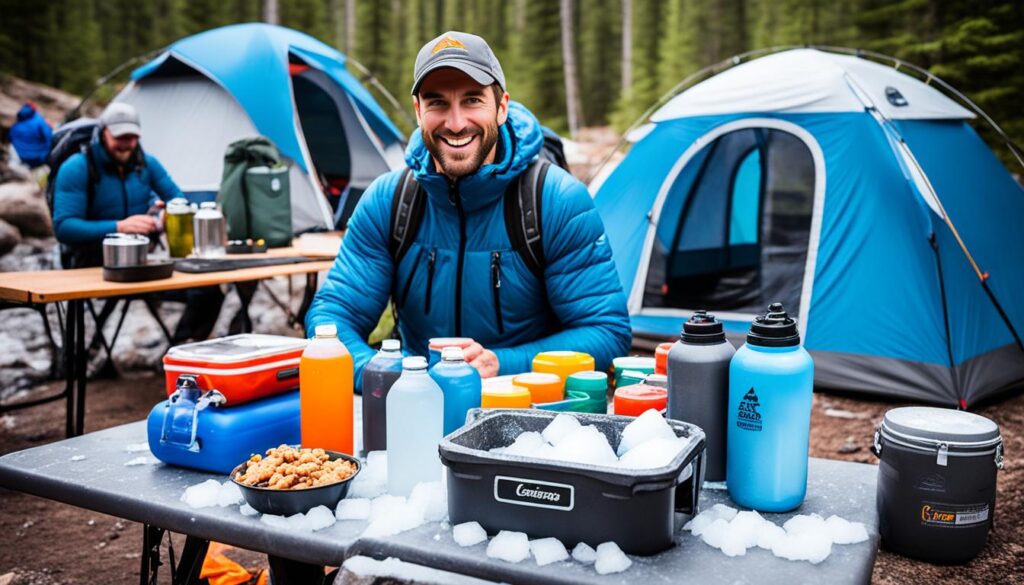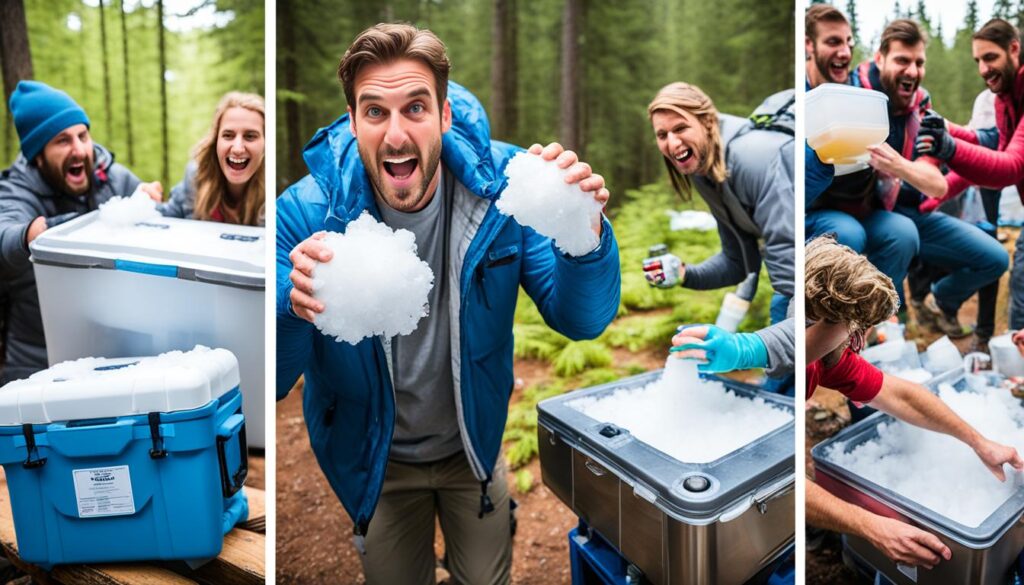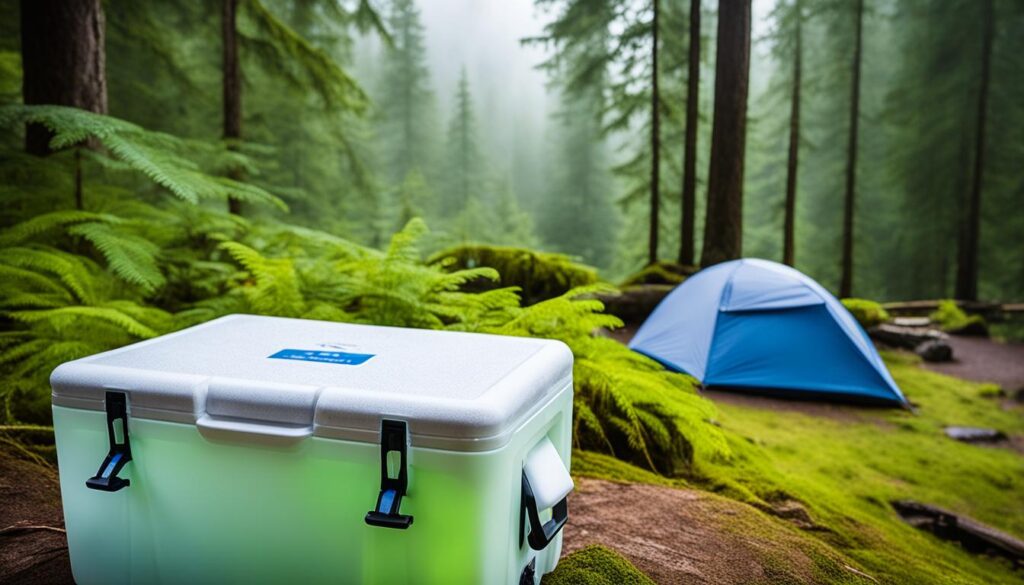Are you tired of dealing with melted ice and soggy food on your camping trips? Looking for a cooler solution that lasts longer and keeps your food fresh without the hassle? Well, look no further! In this guide, I will take you through everything you need to know about using a dry ice cooler for your camping adventures.
Imagine having a cooler that stays cold for days, taking up less space in your car and keeping your food dry. Sounds too good to be true, right? But I assure you, it’s not. With the benefits that dry ice offers, you can take your camping experience to a whole new level.
Get ready to learn some valuable camping tips, discover genius dry ice cooler hacks, and find out why dry ice is the secret ingredient you’ve been missing on your outdoor adventures. Let’s dive in!
What is Dry Ice and Why Use it for Camping?
Dry ice, also known as solid carbon dioxide (CO2), is a unique cooling agent that offers numerous advantages for camping enthusiasts. Unlike traditional ice, dry ice sublimates directly from a solid to a gas, eliminating the need for messy melting and leaving no water residue behind. Its freezing temperature of -78.5°C (-109.3°F) makes it an extremely cold and effective cooling solution.

Dry ice provides longer-lasting cold storage compared to regular ice, which means you can keep your food fresh for extended periods during your camping trips. This makes it perfect for keeping perishables, such as meats and dairy products, safe and chilled throughout your outdoor adventure. Additionally, dry ice takes up less space in your cooler, allowing you to maximize the storage capacity for other essential items.
One of the significant advantages of using dry ice for camping is that it keeps your cooler water-free. As it sublimates into a gas, it leaves no liquid behind, preventing your food and drinks from becoming waterlogged and contaminated. This eliminates the need for constantly draining meltwater and helps maintain the freshness and quality of your camping provisions.
Aside from its cooling properties, dry ice is a versatile tool that can enhance your camping experience in various ways. For example, you can use it to create captivating fog effects, perfect for setting an atmospheric ambiance during evening gatherings around the campfire. Additionally, dry ice allows you to make instant ice cream and cocktails, providing a fun and refreshing treat for you and your fellow campers.
How to Properly Use Dry Ice in a Cooler
When it comes to packing dry ice for camping, proper handling and precautions are essential for a safe and effective experience. By following a few packing tips and safety guidelines, you can ensure that your dry ice stays cold, your perishables remain fresh, and your camping trip goes smoothly.
Protective Gear and Pre-Cooling
- Wear gloves: Before handling dry ice, make sure to protect your hands by wearing thick gloves. This will prevent any direct contact with the extremely cold dry ice.
- Pre-cool the cooler: To maximize the effectiveness of the dry ice, it’s recommended to pre-cool your cooler using regular ice or refrigerated items. This helps maintain a cold temperature once you add the dry ice.
Insulation and Placement
Insulating the dry ice and strategic placement within the cooler are crucial for optimal cooling and safety:
- Wrap the dry ice: Insulate the dry ice by wrapping it in newspaper or cloth. This provides an extra layer of insulation and helps slow down sublimation.
- Place on top: Position the wrapped dry ice on top of perishable items in the cooler. This ensures that the cold air from the dry ice will circulate downward, keeping your food and drinks consistently chilled.
CO2 Venting and Safety Precautions
Venting the cooler to release carbon dioxide (CO2) gas is crucial for safety:
- Open the cooler periodically: To prevent a buildup of CO2 gas, open the cooler regularly during your camping trip. This allows the gas to escape and fresh air to circulate inside the cooler.
- Avoid sealed containers: Do not seal any containers tightly, as the buildup of gas could cause them to burst. Instead, use loosely sealed containers or lids with vent holes to allow gas to escape.
- Keep dry ice away from children: Ensure that dry ice is always kept out of reach of children, as direct contact can cause burns. Educate everyone in your camping group about the potential hazards and proper handling of dry ice.
Safety First, Enjoyment Second
By following these packing tips and safety precautions, you can safely use dry ice in your cooler for a successful camping trip. Remember to prioritize safety, vent the cooler regularly, and handle dry ice with care. This will allow you to enjoy the benefits of longer-lasting cold storage and a water-free cooler, enhancing your camping experience.
| Packing Tips for Using Dry Ice in a Cooler | Key Safety Precautions |
|---|---|
| 1. Wear gloves to protect your hands from extreme cold. | 1. Open the cooler periodically to release CO2 gas. |
| 2. Pre-cool the cooler with regular ice or refrigerated items. | 2. Avoid sealing containers tightly to prevent bursting. |
| 3. Wrap the dry ice in newspaper or cloth for insulation. | 3. Keep dry ice out of reach of children to prevent burns. |
| 4. Place the wrapped dry ice on top of perishable items. |
Advantages and Disadvantages of Using Dry Ice in a Cooler
Using dry ice in a cooler offers several advantages and disadvantages that campers should consider before deciding to incorporate it into their camping experience.
Advantages of Using Dry Ice
- Lower Temperature: Dry ice is colder than traditional ice, allowing for better preservation of perishable foods.
- No Melted Water: Unlike regular ice, dry ice does not melt, eliminating the need to drain water from the cooler.
- Lighter Weight: Dry ice is lighter than water ice, which means it takes up less space in the cooler, leaving more room for food and drinks.
Disadvantages of Using Dry Ice
- Shorter Shelf Life: Dry ice has a relatively short shelf life, typically lasting only a few days. This can be a limitation for longer camping trips.
- No Freezer Storage: Dry ice cannot be stored in a typical freezer due to its extremely cold temperature. This may limit its convenience for campers who rely on freezer space.
- Risk of Skin Burns: Dry ice can cause severe skin burns if it comes into direct contact with bare skin. Caution must be taken when handling and storing dry ice.
Understanding the pros and cons of using dry ice in a cooler can help campers make an informed decision that aligns with their specific camping needs and preferences.

Conclusion
In conclusion, dry ice is a valuable tool for camping enthusiasts looking to keep their food and drinks cold during their outdoor adventures. By following safety precautions and proper handling techniques, campers can enjoy the benefits of dry ice cooling for camping.
Using dry ice in a cooler offers several advantages. It keeps food fresh for longer periods, eliminating the need for constant ice replacements. It also creates a mystical ambiance with fog effects, adding a touch of magic to the camping experience. Additionally, dry ice allows for the preservation of wet ice, preventing the hassle of dealing with melted water in the cooler.
However, it’s crucial to prioritize dry ice cooler safety. Wearing gloves and taking necessary precautions when handling dry ice can prevent skin burns. Venting the cooler to release carbon dioxide gas is essential for maintaining safety. Proper planning, such as pre-cooling the cooler and strategically packing the dry ice, ensures optimal performance.
Overall, camping with dry ice provides a more efficient and effective way to keep food and drinks cold. Incorporating this cooling method into your camping routine can elevate your outdoor experience, offering convenience, freshness, and a touch of enchantment.
What is dry ice and how can it be used for camping?
Dry ice is a solid form of carbon dioxide that can be used as a cooling agent in a cooler for camping. It offers longer-lasting cold storage compared to traditional ice, takes up less space in the cooler, and keeps your cooler water-free. It can also be used for creating fog effects, making instant ice cream and cocktails, and preserving wet ice.
How should I pack dry ice for camping?
To pack dry ice for camping, you should take protective measures by wearing gloves, pre-cool the cooler with regular ice, wrap the dry ice in newspaper or cloth for insulation, and strategically place it on top of perishables in the cooler. It’s important to vent the cooler to release CO2 gas and follow safety precautions when handling dry ice.
What are the advantages of using dry ice in a cooler?
Using dry ice in a cooler offers advantages such as its colder temperature, the absence of melted water, and its lighter weight compared to traditional ice. It can keep perishables fresh for longer periods and is a versatile tool for camping activities.
What are the disadvantages of using dry ice in a cooler?
There are a few disadvantages to using dry ice in a cooler. It has a shorter shelf life and cannot be stored in a freezer. Additionally, if not handled properly, it can cause skin burns. It’s important to understand these limitations and take appropriate safety precautions when using dry ice in a cooler.
Can dry ice be used in a backpack?
Dry ice should only be used in a rigid cooler. For safety reasons, do not use dry ice in a backpack cooler.






